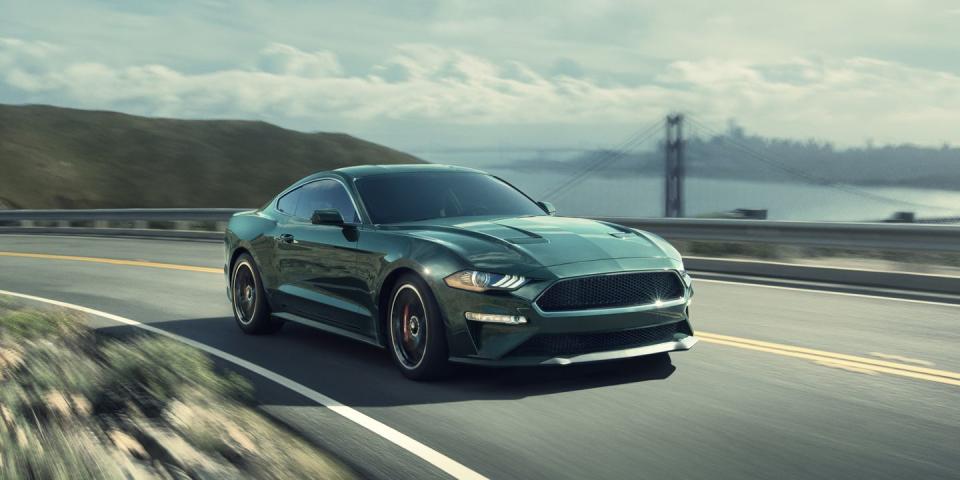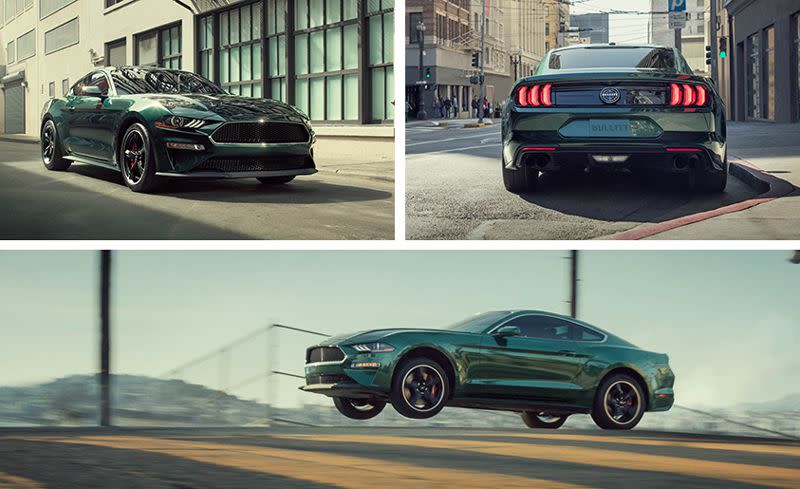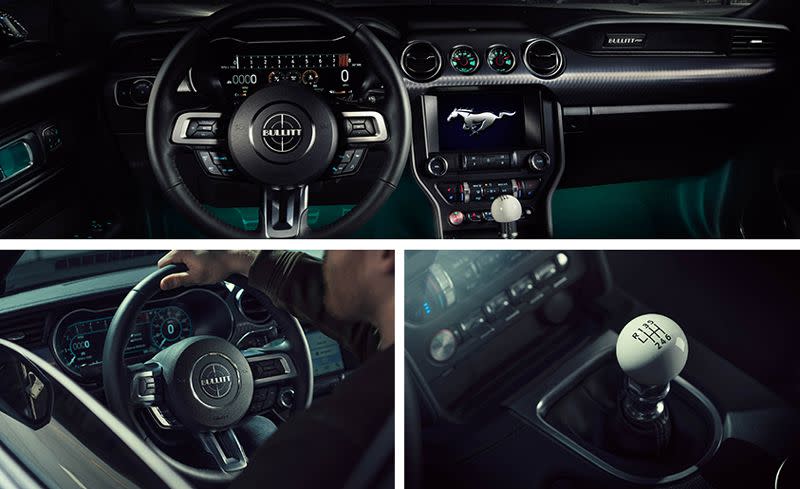2019 Ford Mustang Bullitt

It’s up there for a reason. The power, that is. So go ahead and use it. Rev the 2019 Ford Mustang Bullitt to its 7400-rpm redline or you’ll not be fully indulging the Bullitt experience. Sure, it sounds good at 4000 rpm, chortling out an unmistakable V-8 purr. By 5500-about 1000 rpm past its torque peak-it’s coming on song and making real yank. But it’s in the upper reaches, beyond 6000 rpm, that this latest version of the Coyote 5.0-liter V-8 is alive, shrieking an all-American opus that encourages repeating. So we repeated.
The Bullitt is back, and we drove it all over Northern California, exploring Gold Country at high revs and high g’s and, of course, visiting San Francisco, where the Bullitt legend will turn 50 this October. Ford will do a two-year run of this limited-edition model for 2019 and 2020, distributing its American legend worldwide. Under its hood lies the most powerful cross-plane-crankshaft Coyote to date, making 480 horsepower and 420 lb-ft of torque.
Deep-Breathing Exercise
The additional oomph-20 horsepower-over the 2019 Mustang GT’s 5.0-liter mill is courtesy of improved flow. Two components make the difference, and both of them come from the flat-crank Voodoo V-8 in the Shelby GT350. That car’s higher-flowing intake manifold with longer runners and its 6-percent-larger 87-millimeter throttle body (2019 5.0-liters use an 82- millimeter throttle body) combine with an open-element air filter to enable the deeper breathing. The Bullitt engine shares its dual port- and direct-injection setup with 2019 models as well as its 12.0:1 compression ratio. It also takes advantage of the 2019 model’s greater-than-5.0 status (5038 cubic centimeters, up from 4951 in earlier versions). This all adds up to several small subpeak bumps in torque (6 to 8 lb-ft) before the shared 420-lb-ft peak. But even after that peak, there’s modest additional torque to be had before redline.
The Bullitt is a driver’s car, but you’ll need to wring it out to know the full depth of its capability. Catch it a gear too high, below 4000 rpm or so, and this engine can feel soft. This isn’t a Chevrolet Camaro SS, which impresses with huge grunt at low engine speeds and feels powerful everywhere. No, the latest Coyote delivers more peak power than the Camaro SS, but it doesn’t satisfy completely until it’s fully unwound. We unwound it on California Highway 49, blitzing the granite canyons with a scree-showering 7400-rpm anthem. The Bullitt does away with the sound tube fitted to the 5.0 liter in 2018 models, which piped intake noise into the cabin. It relies instead on a recalibrated active exhaust as well as the natural harmonies that are now more audible through the open-element filter. And, Ford admits, some sound is filled in from the car’s speakers.
There’s a single transmission, a six-speed manual, now fitted with active rev matching, which the Bullitt will share with all manual-equipped GTs for 2019. It’s a sweetheart, too, snapping off smooth, precise shifts even if its gearing is ultralong. Third gear, in fact, is good for well beyond 100 mph, making canyon runs an almost entirely single-gear endeavor. And that is where this Mustang shines, with immediate responses from its steering and brakes; only small, precise inputs are required to make impressive speed. Six-piston front Brembo calipers are part of the package, and they tolerate even an immodest beating well.
Three Options, Two Colors
The Bullitts we drove were fitted with the $1695 magnetorheological dampers, one of only three available options. Six driving modes remain: Normal, Sport, Track, Snow/Wet, Drag Strip, and MyMode, a customizable option that allows full independent control over steering effort, exhaust, damping, and more. Even in Normal mode, the Bullitt suspension is stiff enough that it doesn’t always get along with road imperfections. Sport mode offered enough control on smooth roads to make us think that Track mode would require not only a track but also even stickier rubber to fully exploit its additional damping. But don’t conclude that the Bullitt’s Michelin Pilot Sport 4S rubber isn’t adequate, because it offers substantial grip combined with wear properties that are far more realistic than the Pilot Sport Cup 2 rubber found on the GT’s Performance Package Level 2 and the Shelby GT350R. The Sport 4S is a remarkable tire-massively grippy, predictable, and never emitting so much as a peep in the hundreds of miles of hard driving we put it through.
Other options are the $1595 leather Recaro seats and the $2100 Electronics package, which includes a 12-speaker B&O Play audio system, blind-spot monitoring, and navigation. Otherwise, the Bullitt is subtle, lacking any side badging and fitted with a wide, unemblazoned grille opening. It’s simple. It’s fast if you’re committed. It’s available only in green or black. And it’ll make your heart melt at 7400 rpm.
('You Might Also Like',)

 Yahoo Autos
Yahoo Autos 
